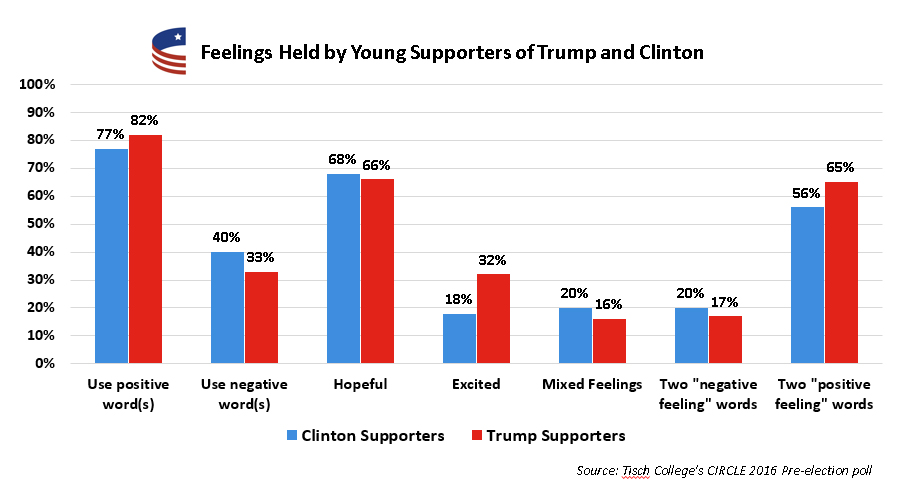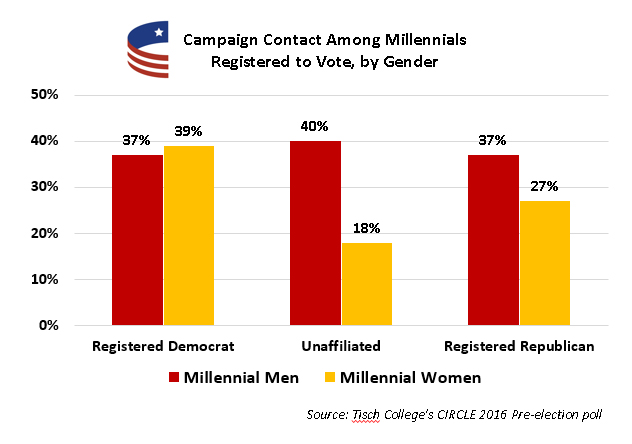Exclusive CIRCLE Poll on Millennial Attitudes about Presidential Election, Contact by Campaigns/Parties
Most Millennials paying attention to presidential election, but far fewer to congressional elections
30% of Clinton supporters contacted by campaigns, 28% of young Trump supporters contacted, 70% not contacted at all
Our new poll of Millennials shows that, contrary to common misconceptions and similar to the primaries, young people are actively engaged in this election through discussion with family and friends and conversations on social media. Yet almost three quarters of Millennials (70%) have not heard directly from a campaign, even though past research and our data confirm that outreach by campaigns increases the likelihood that a young person will vote.
CIRCLE developed the survey and the polling firm GfK collected the data from their nationally representative panel of respondents between September 21 and October 3, 2016. The final sample includes a total of 1,605 people aged 18 to 34 in the U.S., with over-samples of Black and Latino youth, and those who are living in potential swing states (AZ, CO, FL, IA, IL, NC, NH, NV, OH, PA, VA, and WI). The main national sample has 1,410 Millennials. The margin of error is +-3.0 percentage points.
Parties and Campaigns Have Yet to Reach Majority of Young Voters: 70% of U.S. youth have not been contacted personally by a party or campaign this cycle
Learning about candidates and issues through direct outreach, and by talking with family and friends, increases turnout by giving people information about the election and candidates, as well as reasons to vote. In this poll, 82% of young people who had been contacted multiple times plan to vote in November, while only 62% of those not contacted plan to vote. In particular, contact is critical for down-ballot races in which youth may not be aware of the candidates.
However, campaigns, parties, and other organizations that promote specific candidates have not yet reached 70% of respondents. Black and White youth are about as likely to be contacted, while Latino youth are less likely to be contacted personally (25%). While this poll focused solely on Millennials, Pew Research recently showed that young people (18-29) were least likely among all age groups to be contacted this cycle. When young people were registered, they were far more likely to be contacted (35%) than those who were not (17%).
Young people living in potential swing states are more likely to be contacted than youth in other states (35% to 25%), and about one quarter of swing-state youth have heard from campaigns multiple times, whereas only 16% of youth in other states experienced that type of outreach.
Overall, men were more likely to be contacted (34%) than women (26%). The gender gap was even larger when considering electoral competitiveness. The rate of contact was 38% among men living in swing states, but just 20% among women in “safe” states. Data clearly indicate that young men who are registered as unaffiliated have been very heavily targeted this campaign season. Among registered youth, 40% of young male independents have been contacted, compared to 18% of young females registered as unaffiliated. However, among registered Democrats, women were slightly more likely to be contacted (39%) than registered Democratic men (37%) and a lot more than Republican (27%) and Independent women (18%). Registered men did not show the same pattern of outreach disparity.
Young People Talking About Election with Friends and Family, On and Off Social Media
Many young people may not be hearing from the campaigns, but they are certainly paying attention to this election by getting information from various sources. Our poll found that a majority of young people are paying attention to the 2016 presidential election (76%), but far fewer are watching Congressional elections (28%).
Not only did our poll show that half of young people (50%) heard about the election through friends and family, but about 59% have talked about the election with friends and family at least occasionally (i.e. often, fairly often, or occasionally) outside of social media: 50% of Black and 58% of Latino youth respondents reported doing so. This type of household and peer-to-peer discussion can be critical to engagement, especially for young people; analysis of the 2012 election by CIRCLE and the Commission on Youth Voting and Civic Knowledge showed that the household and immediate community had a greater impact on individuals’ political engagement than many other factors.
The percentage of youth talking about this election with friends and family is slightly lower in swing states (57%) than in other states (61%), possibly suggesting that young people in swing states may expect more disagreements about politics, or that they are simply fatigued due to the constant media coverage about the election in those states. Among all youth in the sample, 43% talk about the election at least occasionally with people with whom they disagree. However, almost half of youth (47%) report avoiding a conversation because of disagreement. Similarly, 41% occasionally avoid posting something on social media because they thought it might “create drama.”
Almost half (43%) of Millennials report seeing “some” or “a lot” of political ads, which may prompt discussion that, in turn, mobilizes youth. Almost three quarters (73%) of Millennials see ads on television, by far the biggest source. In fact, TV is the only source of political ads for 24% of youth. However, it it is unclear whether the ads are coming through streamed content or on cable and network TV.
The rates of political ad exposure depended in part where Millennials live: 52% of Millennials living in swing states see “some” or “a lot” of political advertisements, but in “safe” states just 34% see ads at this rate. Although the overall gender difference was negligible (42% for men, 44% for women), this trend masks the significant variations by gender and registered Party identification, as shown in the graph below.
The Presidential Candidates and Millennials
While much attention has been paid to Democratic candidates’ reliance on young voters, only 30% of Clinton supporters have been contacted by any campaign, while 28% of young Trump supporters have been contacted. Conflicts between the Trump campaign and the Republican Party may not bode well for increasing youth outreach.
For some youth, contact may not matter, as 37% of unlikely voters in this poll said that they would not vote because they have so far been unable to find a candidate they can support. In fact, as of early October, according to our poll, no candidate yet had the support of a majority of youth, though Clinton led others by a large margin. Namely, among likely young voters, Clinton beat Trump by 21 points (49% vs. 28%).
If Donald Trump’s level of youth support holds or decreases, it would be unprecedentedly low for a Republican presidential candidate (historically, youth have divided their vote between Democrats and Republicans). While we report data here for 18 to 34-year-olds, in 2008 Senator McCain received 32% support from 18 to 29-year-olds. Although the overall level of support for Trump is very low, his supporters may be more energized. The Millennials who say that they would vote for Donald Trump were more likely to say that they will cast a ballot (76%) than Clinton supporters (68%).
The poll suggests that a vast majority of young supporters of both Clinton and Trump have at least some positive feelings about their chosen candidate, but many hold mixed or outright negative views of the candidate that they are voting for. We asked all respondents to choose two words that describe how they feel about their candidate choice. Here, we define positive words as “passionate,” “excited,” and “hopeful,” while we define negative words as “apathetic,” “angry,” “disappointed,” and “confused.”
Secretary Clinton has a very large lead over Trump among Millennials, and while a majority (77%) of her supporters have at least some positive feelings about her, 40% of young Clinton supporters used at least one negative word to describe their feelings. The most commonly used word was “hopeful,” which was chosen by 68% of Clinton supporters, followed by “passionate” (36%). That said, 20% of her own supporters chose to use two negative words to describe their feelings. These findings suggest that many of Clinton’s supporters still have some reservations, albeit mixed with hopefulness.
Donald Trump’s young supporters, though fewer in number than Clinton’s, appear more energized and less ambivalent about their candidate. Among Trump supporters, 82% use at least one positive word and 33% use one or more negative words. Trump supporters were as likely as Clinton supporters to use the words “hopeful” (66%) and “passionate” (36%) but more likely to report feeling “excited” (32% vs. 18%). Overall, Trump’s supporters were more likely to use two positive words to describe their feelings about him (65%) than Clinton supporters did about her (56%). African-American voters have provided a reliable and active base of support for President Obama and other Democratic presidential candidates in recent decades. Black youth also had the highest turnout of any demographic portion of young people in the 2008 and 2012 elections. This trend continues with young African Americans in 2016, but to a lesser degree. Their support for Clinton this year is weaker than it has been for President Obama: 80% of African American youth say they would support Clinton, while around the same time in 2012, 93% of Black youth were backing Obama, according to our 2012 poll of 18 to 29-year-olds. Furthermore, only 62% of Black youth in our sample are “likely voters,” compared to 72% of White youth and 66% overall.
African-American voters have provided a reliable and active base of support for President Obama and other Democratic presidential candidates in recent decades. Black youth also had the highest turnout of any demographic portion of young people in the 2008 and 2012 elections. This trend continues with young African Americans in 2016, but to a lesser degree. Their support for Clinton this year is weaker than it has been for President Obama: 80% of African American youth say they would support Clinton, while around the same time in 2012, 93% of Black youth were backing Obama, according to our 2012 poll of 18 to 29-year-olds. Furthermore, only 62% of Black youth in our sample are “likely voters,” compared to 72% of White youth and 66% overall.
CIRCLE will be releasing ongoing analysis from this national and battleground-state youth poll.







